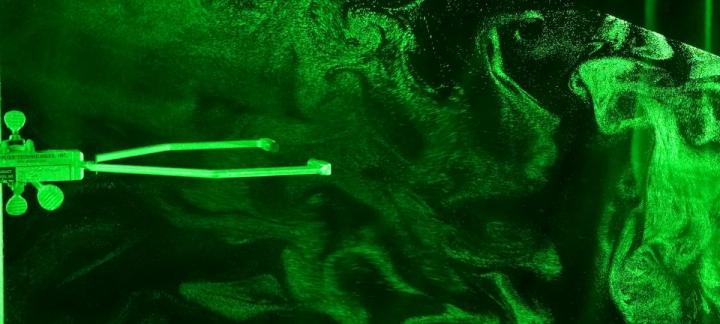
Credit: Will Cantrell/Michigan Tech
Chat with an atmospheric scientist for more than a few minutes, and it’s likely they’ll start advocating for a planetary name change. Planet Ocean-Cloud is much more fitting than Earth, they’ll say, when so much of our planet’s life systems are affected by the interactions of clouds and the oceans.
The ability to predict the behavior of clouds gives meteorologists, climate scientists, physicists and others a better understanding of change of precipitation (currently one of the most difficult aspects of weather forecasting to predict) and improves climate modeling.
Last week, Prasanth Prabhakaran, Will Cantrell and Raymond Shaw, along with several coauthors, published “The role of turbulent fluctuations in aerosol activation and cloud formation” in the journal Proceedings of the National Academy of Sciences. Their article asks: Under what environmental conditions do cloud droplets form? Does turbulence — the chaotic air motion that results in a bumpier ride on an airplane — affect the properties of clouds, such as how many cloud droplets they have and whether they will produce precipitation?
“There are very few absolutes in life and I’m about to give you one of them: When you look up in the sky, every cloud droplet you see formed on a preexisting speck of dust. But not every speck of dust will give you a cloud droplet,” said Will Cantrell, professor of physics.
“If you give me the atmospheric conditions, I can give you a pretty good idea of whether the speck of dust will form a cloud droplet. So far in atmospheric science, what we haven’t accounted for is the fact that the atmosphere is turbulent,” Cantrell said. “If the dust particles were identical, but they are exposed to different conditions, that will play a role in whether they become cloud droplets.”
The role of turbulence in cloud formation is the gap Cantrell’s research steps into. Traditionally, the mechanics of cloud formation have not accounted for turbulence. Prabhakaran and coauthors have developed a framework, backed with experiments from Tech’s cloud chamber, to explain how preexisting aerosol (dust) particles — the seeds of cloud droplets — make the transition to becoming droplets (and thus become eligible to start the process of falling on your garden).
Michigan Tech’s cloud chamber is one of only two in the world capable of performing such experiments. Shaw, distinguished professor of physics and director of Michigan Tech’s atmospheric sciences PhD program, is also affiliated with the other: the LACIS-T chamber in Leipzig, Germany, at the Institute for Tropospheric Research. Clouds can be maintained for hours in Michigan Tech’s chamber, a huge advantage over in situ experiments in a jet outfitted with measurement equipment traveling a hundred meters a second through a cloud.
“Under controlled conditions we investigated the aspects of cloud formation,” said Prabhakaran, who is a postdoctoral research scholar in Michigan Tech’s department of physics. “Modeling under different regimes shows how cloud droplets form and the significance of formation of cloud droplets under the conditions we have, whether it’s a highly polluted environment or out in a relatively clean environment like out over the ocean.”
Atmospheric conditions matter: In clean conditions, all researchers need to know are the mean values such as average water vapor concentration and average temperature, to have enough information to predict whether dust specks will become cloud droplets. Under more polluted conditions, the exact conditions the particles are exposed to becomes more important.
“The way that clouds interact with sunlight and whether they precipitate will depend a lot on how many droplets and how big they are,” Cantrell said. “Understanding the transition from dust to cloud droplets is a key part of understanding whether you’ll have a lot or few droplets. Our theory adds a way to understand whether the turbulent mixing in the atmosphere will affect the number of droplets you get, and that cascades into other properties of cloud formation.”
To conduct the experiment, the researchers created a turbulent environment inside the 3.14 meters cubed cloud chamber by heating the chamber’s lower plate and cooling the top plate to create a turbulent, convective flow. Into the flow the team introduced 130-nanometer sodium chloride aerosol particles. By varying the temperature differential between the top and bottom plates and the number of aerosol particles in the chamber, the researchers saw differences in how clouds formed.
Based on those observations, the research team developed a semiquantitative theory to describe the conditions. Whether aerosol particles become droplets has a tremendous effect on the properties of clouds, and the Michigan Tech experiments and model provide a framework to categorize droplet formation in numerical models.
Cantrell said turbulence has not been a part of the cloud physics curriculum until very recently.
“Our measurements in the chamber show that turbulence can mimic the behaviors that have been attributed to particle variation, primarily size and composition. This experiment changes our understanding of the properties of the clouds and we become better able to represent those processes in climate models,” he said.
The researchers said their model will help forecasters predict the fluctuations Planet Ocean-Cloud will experience as the climate changes.
“Hopefully within a few years, this will improve the observations of climate models for predicting long-term climate change,” Prabhakaran said.
###
Media Contact
Kelley Christensen
[email protected]
Original Source
https:/
Related Journal Article
http://dx.




